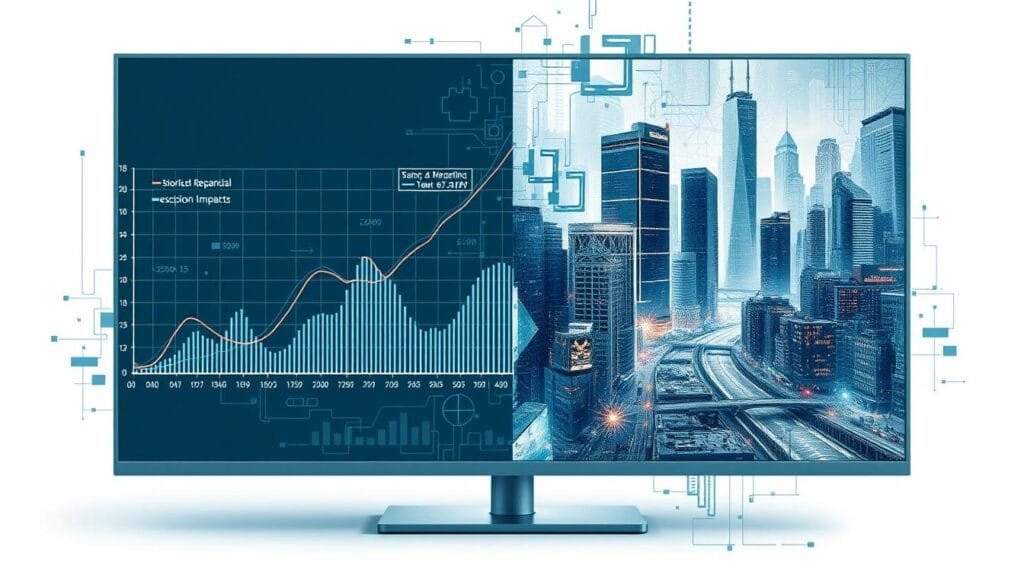Can economists really foresee recessions, or are their predictions just guesses? Predictions vary widely. Historical data shows they often miss the mark. This makes a careful look into the truth of recession forecasting very important.
From a survey by the Philadelphia Fed pointing to a 34.4% chance of a downturn, to Wells Fargo’s alert of a coming mild recession in 2023, we see a wide range of predictions. These examples show how tricky and uncertain economic forecasting is. Interestingly, forecasters failed to see 148 of the last 150 recessions coming. For example, in early 2001, projections missed by forecasting a 2.5% GDP growth, which actually was just 0.5%. The end of 2007 was similar, with a forecast 2.2% growth that ended up at 0.6%.
This shows big mistakes in macroeconomic analysis. It makes us wonder: Can we really trust economic predictions?
Let’s explore the tricky world of recession prediction models. We’ll look at everything from old-school methods to the latest in machine learning. We’ll see what this means for the economy’s future and for research ahead.
Key Takeaways
- The Philadelphia Fed’s survey indicates a 34.4% chance of an upcoming recession.
- Historically, forecasts have missed 148 out of the last 150 recessions, highlighting their unpredictable nature.
- AI and machine learning techniques enhance economic forecasting precision.
- The findings align with forecasts from major financial institutions like Goldman Sachs and diverge from the general consensus.
- Understanding business cycle turning points remains a significant challenge for economists.
The Challenges of Predicting Recessions
Predicting economic recessions is hard because the global economy is complex. Random economic forces and business cycle dynamics add to the difficulty. This complexity makes forecasting very challenging.
Introduction to the Problem
Policymakers and businesses need to know when downturns will happen. But accurate predictions are hard to come by. Unpredictable events, like sudden changes in demand and supply, make it even tougher. These events can throw off forecasts, leading to major errors.
Common Forecasting Errors
Forecasters often make big mistakes, as history shows. For example, in early 2001, they were way off. They predicted a 2.5% GDP growth, but it was only 0.5%. Similarly, in late 2007, their 2.2% growth prediction was six times too high. These errors show how hard it is to get predictions right, often because of misplaced optimism or pessimism.
Understanding Business Cycle Turning Points
Knowing when the economy will turn is tough. Many factors influence business cycles. This makes knowing if the economy will grow or shrink difficult. Random events, like a drop in demand or supply issues, add to the unpredictability.
Yet, new tools and methods, like machine learning, are helping. They might make recession forecasts better. Knowing the challenges in forecasting can help us build better tools. These tools can help policymakers lessen the blow of downturns.
Probabilistic Models and Economic Indicators
We face challenges in the economy. To foresee downturns, we use tools like probit models economics and logit models recession prediction. These models help by looking at financial signs to predict recessions. While helpful, they’re not perfect, especially in different countries.
Probit and Logit Models
Probit and logit models are key in guessing recession chances. They use past data and look at things like job rates, inflation, and bond rates. For example, the difference between 10-year and 3-month Treasury rates is a known recession hint. If this spread goes negative, it often means a recession is near.
These models spot recessions by noticing economic shifts. Interestingly, low joblessness doesn’t always mean economic health. In early 2022, even with stable job rates, the economy dipped, showing job rates don’t tell us everything.
Key Financial and Economic Indicators
Important financial signs help fine-tune economic indicators analysis. These include:
- Unemployment Rate: Recessions often come with quick job loss.
- Inflation: High inflation has led to swift actions by financial authorities to change interest rates.
- Yield Spreads: The difference in bond rates, like the 10Y3M, helps guess recession risks.
We measure yield spread’s success by seeing how often it’s right versus wrong. Good measures have higher ROC curve areas. Data from 1962 to 2017 shows this method’s strength.
Limitations in Existing Studies
Even with the success of Probit models economics and Logit models recession prediction, challenges remain. Changes in economic traits across countries can reduce model accuracy. Picking the best predictors is also tricky. Plus, new indicators have given mixed forecasting results.
In assessing model accuracy, continual improvement is necessary. By March 2022, the chance of recession within a year was about 5 percent. This tells us to be cautious but not anxious.
| Indicator | Key Measure | Recession Predictive Power |
|---|---|---|
| Unemployment Rate | 0.75 percentage points (80th percentile) | Historical association with sharp increases during recessions |
| Inflation | Elevated levels not seen in decades | Leads to rapid increases in federal funds target rate |
| Yield Spreads (10Y3M) | Inverted yield curve indicates a recession | Critical value of zero for prediction |
Machine Learning in Recession Prediction
Machine learning is changing how we forecast economic downturns, especially in OECD countries. It deals with big datasets and complex variables better than old models. By doing this, it tests its ability to predict recessions in different economies. Its strength in performance outside the sample is notable.
Overview of Machine Learning Methods
Machine learning in economics uses advanced techniques for better predictions. These include logistic regression and random forests. The ensemble model, which combines these methods, has shown high accuracy.
It reached an 89% Average Underlying Accuracy in forecasting downturns. This model also had an AUC of 0.90. That’s better than many single models like the logistic regression at 0.82. These modern methods are more accurate and reliable than old forecasting models.
Application to OECD Countries
The use of machine learning has changed economic forecasts for OECD countries. With up to 166 indicators, institutions like the IMF can predict recessions more accurately. Wells Fargo uses about 6000 variables but focuses on 190 key ones for practical forecasts. This detailed method improves how we forecast recessions, making predictions robust and thorough.
Comparison with Traditional Models
Traditional forecasting models often fall short because they can’t handle big datasets well. Machine learning is a game-changer, offering precise predictions by optimizing data use. For example, machine learning has improved accuracy by up to 89% over old techniques.
Ensemble models in machine learning have also shown to outperform standard methods. Their superior performance is evidence in validation tests. This shows how advanced machine learning is compared to traditional econometrics.

| Model | Accuracy (%) | AUC |
|---|---|---|
| Logistic Regression | 82 | 0.82 |
| XGBoost | 89 | 0.90 |
| Random Forests | 89 | 0.89 |
How Accurate is Economics at Predicting Recession
Figuring out if economic predictions are accurate is key for both policymakers and investors. By looking at past cases of recession predictions, we learn about the hits and misses of economic forecasts. Even with new technologies and models, predicting recessions can still be hit or miss.

Case Studies and Historical Accuracy
Looking at the past, economic predictions have been a mix of right and wrong. A survey by the National Association of Business Economics found that 38% thought a recession would happen in 2020. Yet, another poll saw only a 33% chance of a recession within the next year. It’s rare for recessions to be predicted nine months to a year before they happen.
The 2008 global financial crisis wasn’t called a recession until almost a year after it began. Research on 153 recessions in 63 countries from 1992 to 2014 showed most weren’t predicted. Also, the number of economists who thought a 2020 recession would happen dropped from 10% in February to just 2% by July.
Factors Leading to Over-Precision
Being too precise is a big problem in economic forecasting. Economists often predict too much growth. For example, forecasters were 53% sure about their predictions, but only 23% of these were accurate. This high confidence didn’t mean they were more likely to be right.
Even seasoned forecasters can be too sure of themselves. Predictions from big organizations like the Bank of England and the European Central Bank often missed inflation rates. Before the 2001 recession, forecasters guessed the U.S. GDP would grow by 2.5%, but it hardly grew. Likewise, before the Great Recession, a 2.2% growth was expected, but it only grew by 0.6%.
In summary, looking at how accurate economic forecasts are shows a big gap between what was expected and what actually happened. If we can learn from these discrepancies, we might get better at predicting future economies.
Out-of-Sample Testing and Performance Metrics
Out-of-sample testing is key for checking the strength of recession risk metrics. It tests a model’s predictions on new data, not used before. This helps see how well a model can forecast, particularly during unexpected market changes.
The study looks at data from February 1973 to September 2019, through many economic cycles. It uses the area under the receiver operating characteristic curve (AUROC) to see how accurate models are at predicting recessions within the next 12 months. Here are some important AUROC stats:
- Long-term spread (TS): 0.70 [0.63, 0.76]
- Near-term forward spread (NTFS): 0.73 [0.67, 0.79]
- Excess bond premium (EBP): 0.78 [0.72, 0.83]
- TS + EBP: 0.88 [0.84, 0.93]
- NTFS + EBP: 0.88 [0.84, 0.92]
- First three principal components of Treasury yields (Tsy 3PC): 0.59 [0.52, 0.65]

When we don’t count recessions, the models’ forecasting power changes. For the long-term spread (TS), it jumps to 0.93 [0.91, 0.96]. But for the excess bond premium (EBP), it drops to 0.59 [0.52, 0.66]. These changes show that out-of-sample testing gives a full picture of a model’s usefulness in different situations.
Monthly re-estimations, adding new data, act like real-world decisions for policymakers. This makes the models more responsive. Here are some comparative AUROC numbers:
| Model | In-Sample AUC | Out-of-Sample AUC |
|---|---|---|
| Baseline (three-year lag of deposit rates dispersion) | 0.86 | 0.80 |
| Counties with at least two banks | 0.73 | 0.62 |
| Counties with more than four banks | 0.80 | 0.71 |
These results show how crucial out-of-sample testing is for analyzing economic models. Using recession risk metrics makes our forecasts more accurate and reliable. This helps policymakers make better decisions.
Implications for Policy and Future Research
Understanding the link between economic trends and forecasting models helps grasp the impacts on economic policy. To make good policies, it’s crucial to predict well. This means we must mix economic wisdom with these models.
Integration of Economic Judgment in Models
When we combine machine learning with economic insight, we get better at predicting downturns. Adding expert opinions to algorithms can fill in missing pieces. This is key because each recession is different. For example, the yield curve is a good predictor, but its effectiveness changes.
“Despite the complexities, improving how expert judgment is applied in conjunction with machine learning can significantly enhance model accuracy and reliability.”
Future Directions for Research
There’s a need for more advanced predictive models in economic research. Adapting these models for a wide range of scenarios is a big challenge. By using better algorithms and diverse indicators, we can improve how policies are made. Looking at how big banks, like the Federal Reserve, create policies can offer insights.
Impact on Policy Making
Better predictions of economic slumps can improve policy decisions. Policymakers use these forecasts to refine strategies, softening the blow of downturns. It’s important to understand financial signs and learn from past policy outcomes. This understanding aids in making plans that reflect economic truths.
Adjusting policy tools according to predictions can help lessen the impact of recessions. This approach leads to stronger economic frameworks.
- Recessions are inherently rare and challenging to predict with certainty.
- The predictive strength of factors such as the yield curve varies across different economic contexts.
- Effective policy interventions are contingent on a nuanced understanding of economic indicators.
Conclusion
In our look at economic forecasting, we’ve checked out different indicators to predict U.S. recessions. We found from 17 key indicators that composite indexes and Treasury yield curves are best. The yield curve, or the spread difference between the ten-year Treasury note and three-month Treasury bill, beats many other indicators.
When we talk about short-term predictions, the yield curve spread is very useful. For example, the chance of a recession changes with the yield curve spread. It can be as low as 10% at a 0.76 percentage point spread to a high of 90% with a -2.40 percentage point spread. The third quarter of 1994 and the early part of 1981 show how accurate these models can be, but also their limits.
We also looked at how well we can predict using the receiver operating characteristic (ROC) curve. Changes in corporate profits, industrial production, and private investment improve our understanding. As we improve economic forecasting, we see good reason for hope but know we must keep researching. The effort to get economic predictions right is ongoing but promising.
FAQ
How reliable is economic forecasting in predicting recessions?
Economic forecasting is tricky. This is because economic systems are complex. Accurately pinpointing when the business cycle changes is hard.
Errors often come from being too optimistic or pessimistic. Sometimes, signals of economic ups and downs are noticed too late.
What are the common errors in recession forecasting?
Forecasters often make mistakes by being overly hopeful or gloomy. They also miss early signs of economic troubles or improvements.
How do probit and logit models contribute to recession prediction?
Probit and logit models use important financial and economic signs to guess recession chances. But, picking the right indicators is tough. It’s also hard to apply these models to every country.
Are machine learning methods more effective in predicting recessions compared to traditional models?
Machine learning offers hope in better forecasting recessions. It’s good at analyzing big data and complex details.
When comparing their performance, these new methods often do better than old ones, especially in tests in different countries.
What historical case studies reveal about the accuracy of economic predictions?
Looking back at history, economic forecasts about recessions have been hit or miss. A big issue was being too sure about the forecasts. This confidence didn’t always match what actually happened.
How important is out-of-sample testing in economic forecasting?
Testing forecasts with new, unseen data is key. It helps check if the forecasting models can handle unexpected market changes.
Economists look at how these models do in real life. It’s a big part of making sure predictions are reliable.
What are the implications of integrating economic judgment in machine learning models?
Adding economic insight to machine learning helps predictions make more sense. It also improves their accuracy.
Future studies aim to make these models even better. This could change the way economic policies are created.
What future directions and implications should be considered in economic forecasting research?
Research should keep working on making models better. This includes being right more often in different economic settings.
By adding in ways to judge economic situations, policies based on these forecasts could become more solid and helpful.
